


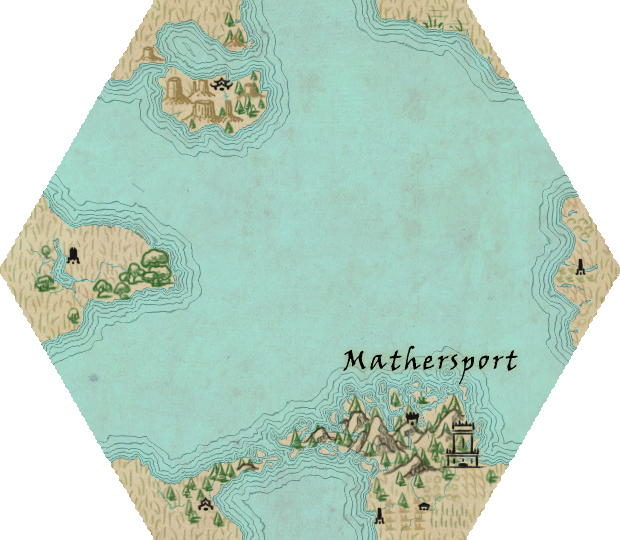










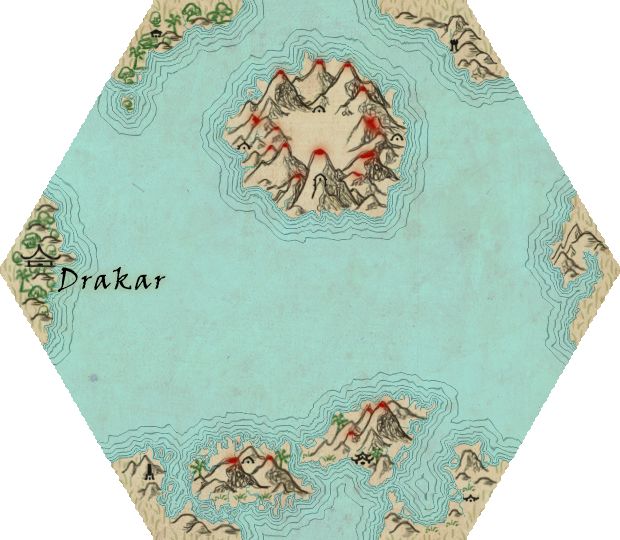
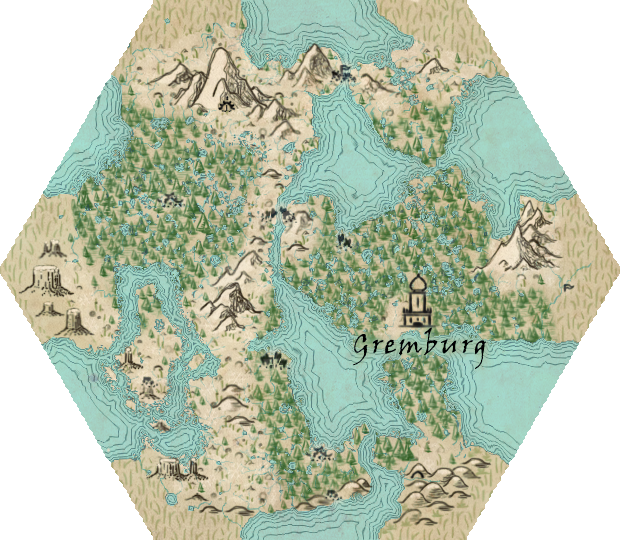
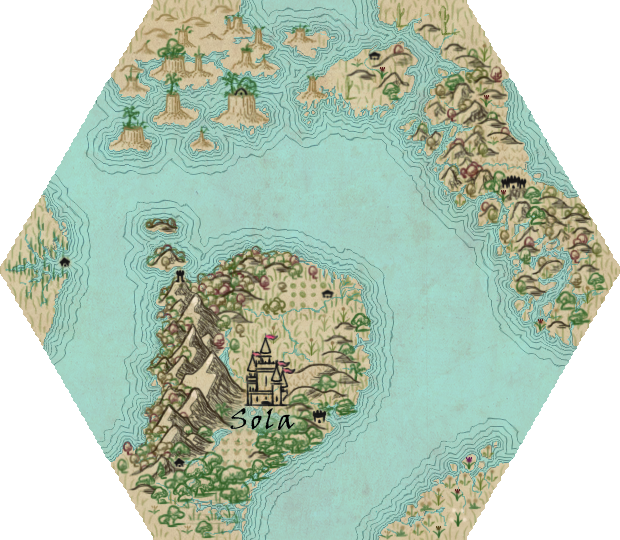
















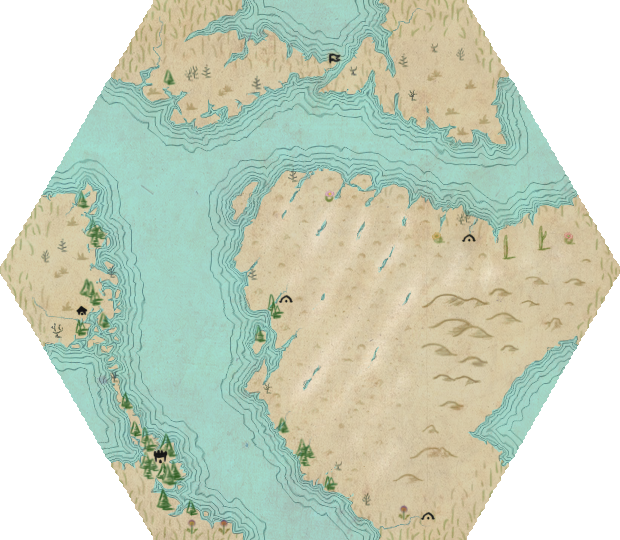






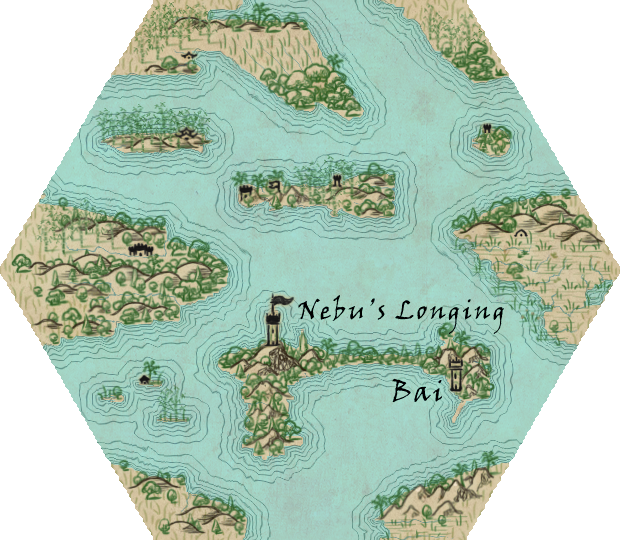




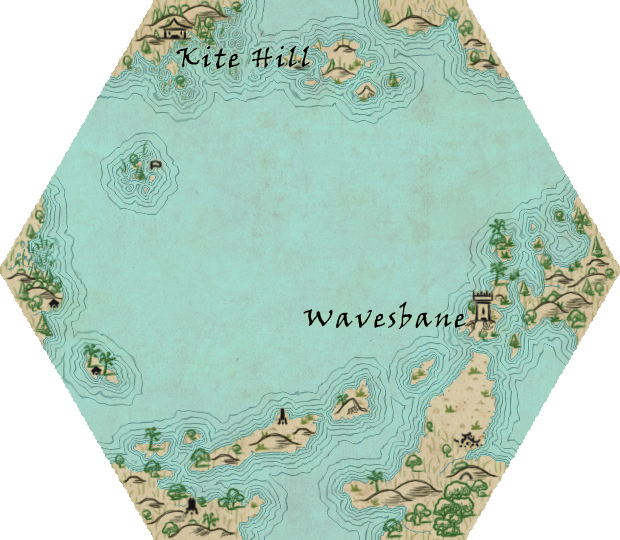







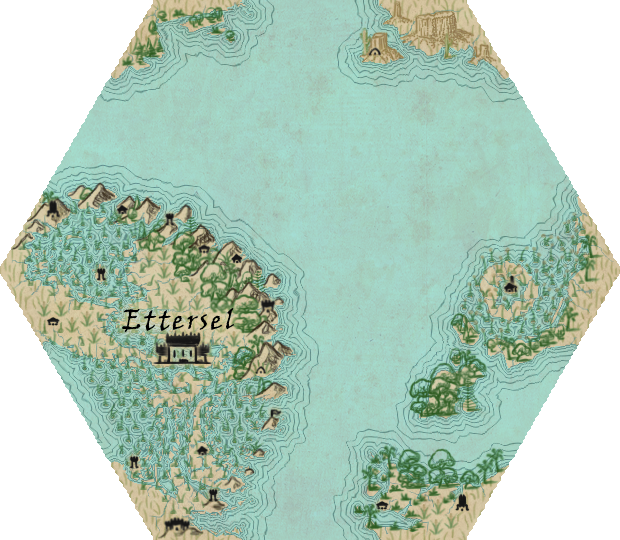
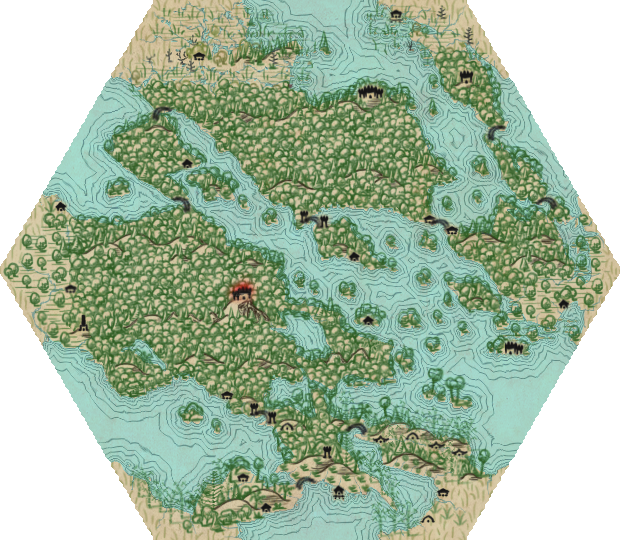

























































































































































































































































































BEHOLD: A MASSIVE WORD-DUMP! A whole bunch of words in one place! Isn't that captivating! You'll definitely stay on this page and read everything, because that's how the internet and human attention spans work. I am so smort at this, yay.
Terra Trema is a modular setting comprised of keystone cities on hex tile maps. The maps can be rotated and arranged in any orientation; they are perfectly hexagonal, and all swaps and rotations produce equally valid maps (though the icons and text are directional). They could be considered geomorphs. (Geomorphs: worth googling, if you aren’t familiar with them.)
What does “Terra Trema” mean?
It’s bad Latin for “quakes land” or “landmass quaking” or some other grammatically incorrect thing. (Update: more grammatically correct now that I updated it to “Terra Trema” from “Terra Contremo” - the latter translates to something like “ground, I shake” whereas the former is more like “ground of shaking”. Close enough.) I gave it this name because of the probable earthquakes associated with having landmasses shift around so much. But divine magic being what it is, the land may not shake at all when the maps are re-drawn; the name of the setting is, optionally, ironic. (The perfect inverse of, for example, N. K. Jemison’s “The Stillness”.)
So the land can shift?
In the setting variant I’m currently using, the land shifts every century or so. You can use the maps to build a “frozen” setting that is fixed in whatever orientation you choose, or a setting where land shifts wildly and makes navigation bizarrely unpredictable. As a compromise, perhaps there was a dramatic remaking of the world during a cataclysmic period in ancient history – but the current map is unchanging. Use the maps and setting however you’d like – the modular, easily-altered nature of the maps is their strong-suit, but it’s by no means necessary to change anything once you assemble a world-map that you like.
How were these maps made?
Most importantly: with the amazing map brushes from StarRaven, on Deviant Art.
Plus some of my own. I used photoshop, and probably too much time nit-picking and pixel-pushing.
So is this just a mapping tool?
Nope, I have a flexible all-purpose fantasy setting to go with it. But feel free to just use whatever parts of it you need; either just the maps or just the setting. The setting is a lot of dense blah blah words blah blah complicated blah blah blah probably people will just use the maps. (But the setting text is worth skimming, if you’re interested. It’s got a decent amount of depth, at the geopolitical and cultural levels.)
So what sort of setting is Terra Trema? I mean, words-wise.
Terra Trema is a flexible multicultural fantasy setting that any fantasy RPG (or possibly steampunk, magepunk, or non-magical alt-fiction) can be thrown into. The approximate feel is something like mid 1600s Earth Earth minus gunpowder and plus a little magic. The setting focuses primarily on the keystone cities. Anything at all can be out in the countryside (that’s up to you!) but the cities have well-developed identities and setting-based plot hooks. Yes it’s slightly skewed toward cities that feel vaguely European-ish, but there is significant cultural diversity both between and within the cities.
What sort of details are included in the setting?
Nothing game-system-specific; in fact, I’ve purposefully left even the historical equivalent period, tech level, and magic level vague. The details mostly concern what can be found in the big cities: the politics, culture, relative influence vs. other cities, relative population, notable structures, some relevant history or recent events, military tactics, government, etc.
Not included are the shop wares and prices; that’s up to you, and depends on the particulars of your system. But the setting does include, for example, indicators of how wealthy a city is, and the primary imports and exports, which can be used to estimate prices and the types of available goods. (If that’s something you’d think would be fun. It’s easy enough to ignore any part of this that you don’t care for.)
Could I use just part of this setting?
Of course! It’s modular, after all. Just ignore any references to cities or styles you aren’t using. You could even use the map tile that a city is on but replace its identity with something you’ve come up with, or declare it to be a ruin. Some cities may not fit with the aesthetic of your campaign or story; for example, one city (Quistria) is populated with elves (which don’t show up in all fantasy settings) and another city is obsessed with magic (which won’t feature prominently in a low-magic or no-magic gritty historical fiction). Other cities might just not be to your tastes. Have them destroyed.
What are the Big Cities? How are they different from the Little Cities?
I’ve marked two different types of cities on these maps: the Keystone Cities (marked in large-scale icons, and labeled in large text) and hundreds of smaller cities / towns / populated* landmarks. The default versions of the map images have only the large cities labeled, though versions with all labels and no labels are available. The former (no labels) is useful if you want to combine these maps with your own custom setting, with your own names and details for everything. The latter is useful when combined with the Terra Trema Setting text. (Update: I’ve gotten lazy and don’t have the all-labeled and none-labeled versions of the newer stuff. But I could produce them if requested.)
*The “Hollowed Lands” (the cold lands surrounding Gremburg) and some other tiles technically have mostly ruined cities marked instead of populated landmarks. These parts of the world aren’t doing so well, as you might guess. Otherwise, all landmarks function like backwater cities: basic amenities (an inn/tavern and small shop, at least) are available to travelers.
Why no roads? Or Boundaries? Or other thing that’s normally on maps? (Contour lines? Compass Rose? Etc.)
If the land keeps shifting, the boundaries would too.
I have versions of Terra Trema that I keep static. On these fixed maps I draw version-specific boundaries or zones of control, and trade routes or roads.
Roads would also shift – though it’s technically possible to include roads that meet at the hexagon points or along the coasts. But there would be a lot of roads that started AND ended in the middle of nowhere. When using these maps, I assume that most overland spans linking two cities or towns would have a road of some sort. (Possibly a very bad sort; travelers take caution.) Like boundaries, feel free to mark these in yourself for your own use.
Another reason I’ve avoided marking formal boundaries and roads on the individual tiles: clutter! There’s already too much clutter on these things. In retrospect, I’ve held to a “more is more” philosophy when making these. Sometimes… less is more? Oh well too late.
Why aren’t there names for countries and regions on these hex maps?
I haven’t added names for countries or regions, because these merge and shift as the hex tiles are rearranged. (I’ve labeled some regions, nations, and oceans in my static versions of Terra Trema. And on the “labeled towns” version I’ve occasionally labeled some landmarks or regions; for example, the Smile and the Crucible, north of Foundling.)
Also, I find I haven’t needed region names. By default, a country or region in Terra Trema is named after its keystone city. The keystone cities are generally capitals of nations (or provinces, principalities, city-states, possibly empires, whatever) and the region directly surrounding them normally bears the same name. (Notable exception in my setting: Mathersport was built in the land known as Mavidris.)
Why aren’t there any labels or names for the small towns and cities?
Because… wait, there are! I have labeled the small towns. There are multiple versions of these map hexes: hexes with small city names, and hexes without. Naming everything makes the maps really cluttered, so I wanted a “clean” version. These maps are already more full of terrain markings and icons than they probably should be – so I have to be mindful of extra stuff.
Yet I had no excuse for not labeling towns and small cities, since they don’t change when the world shifts. (Though some of them may fall under the jurisdiction of different keystone cities, depending on how the tiles are arranged.) So feel free to use whichever versions make more sense for you. I use the unlabeled versions, but refer the labeled maps when I forget the name or location of a town or landmark. (Update: I haven’t bothered with small town names for all of the newer hex tiles - past #30 or so.)
Why is this mapping system so focused on cities, anyway?
Cities are what define and underpin civilizations. This was true ever since agriculture became a big deal, and is only slightly less true now that the internet and fast travel options have made the countryside more integrated into civilization.
Cities matter like nothing else does. Nowhere is this more true than in economics. Great further reading can be found here:
http://www.zompist.com/jacobs.html
Most stories, games, and personal travels will heavily feature cities; they are, at the very least, required jumping-off points and resupply centers. That treasure you find in the forbidden temple? You’ve gotta get to a city to sell it. Need to do some research? Important books, trainers, mentors, and consultants, and monuments are most commonly found in cities. Want access to natural resources? You could go grow or harvest them yourself in the wilds, assuming whoever owned those wilds didn’t attack you… or you could pay efficient professionals who have already done the harvesting and the growing and brought their wares to the city. Need something from a far-off land? You could travel to that far-off land, or you could buy (steal?) the thing from someone else who’s already made the trip. That someone else will, of course, be in a city. Even before counting explicitly urban-focused adventures, cities are core and key to any adventure, story, game, or quest.
Even when campaigns don’t feature cities, it helps to be able to visualize and explain the peoples & influences (cultural, economic, and militrary) nearby.
So the big cities on these maps are important?
So important, in relative terms, that I’ve devoted most of the setting text to them. (And the remainder is mostly devoted to the small cities and populated landmarks.) These cities are the keystone cities; nexuses of transportation, commerce, imperialism, culture, shelter, politics, and (when necessary) defense. They are each the capital of a broader political entity of some kind – but the precise boundaries of the territory they influence are unimportant, and likely shift even without the map being moved.
Do the cities have statistics?
Okay, this is admittedly a leading question. Nobody is going to ask this question. But I wanted to get it out there: these cities have statistics! Yay numbers! Much of the worldbuilding I’ve done is in terms of quantitative and semiquantitative values, statistics, and sliding scales.
The core mechanical statistics for a city are its population, economic influence, cultural influence, military influence, and defense. These are all unit-less; they are for making relative comparisons between cities.
Mechanics for modeling conflict between cities:
(Yeah, I’ve stopped pretending these are questions by this point.) If you’d actually like to mechanistically model rivalry or combat between cities in an explicit way, these stats can be added to opposed d20 rolls, or define the size of a dice pool. For example, when deciding the outcome of a war or battle between two nations, roll d20 + military influence for both nations, or (depending on the nature of the war) d20 + military vs. d20 + defense. The nation with the highest total number wins – or, well, loses the least. Not all wars have winners per se.
Other rivalries can be modeled in this way as well. Whose merchants get the new lucrative trade agreement? Make an opposed “economic influence” roll. What are all the kids listening to these days? Look on the map for the closest cities, and make an opposed “cultural influence” roll to decide which city’s bards are hot right now. These rolls probably won’t come up often, but it’s handy to have the mechanic available. This is especially true if a group of adventurers have invested in the growth of a particular city; for example, increasing its stats. (The details of how that works are up to you.)
An alternate approach: use a ruler (or count distance in hexes) to determine which cities are more influential at a certain point. Each city’s zone of control can be determined as a circle centered on itself, with a radius equal to its influence stat. There are three types of zones: cultural, economic, and military. So a city with a high economic, middling cultural, and low military influence stat will influence and control the economies of very distant towns and cities, dictate the culture of towns and cities fairly nearby, and actively patrol or guard only a thin ring of countryside outside its city walls. Formal political boundaries may not match any of these three zones of control – though they’re most likely to correlate to the military-influence zone.
Optionally, zones of control can end at mountain ranges and ocean coasts. (Ending at ocean coasts is more likely for a land-focused city, like Neven / Smantus / Pulabat, vs. an ocean-focused city, like Alba / Yozai / Lailan.)
What is the Technology Level or Historical Period of Terra Trema?
The Maps don’t dictate any particular technology level, or even a specific scale. Even the text descriptions and stats for the setting are purposefully ambiguous regarding scale and tech-level. Things that seem period-specific show up on occasion; for example: ballistae, catapults, corporations, sieges, fireworks, stone weapons, and serfs. But all of these things have existed on Earth at the same time. Like Earth, Terra Trema has a wide range of technology use – both on the city level and on the regional level. Not to mention, artifacts from the past linger. (Earth example: Europe still has plenty of castles, despite the fact that heavy cannons outmoded these as bastions of defense many hundreds of years ago.) Unlike Earth, Terra Trema is modular – which means you can simply ignore / not use any city or map tile that would feel out of place or culturally improper in your setting.
The “sweet-spot” for this setting – what I have in mind as I write it – is late Renaissance ideals and styles mixed with early Renaissance or late Medieval levels of technology (especially military technology; gunpowder is rare.) But it can be readily adapted to anything from the early Bronze Age to High Steampunk. (Railroads sold separately. Do not pass 1900 AD, do not collect space-age technology. As necessary, replace “Renaissance” with Mughal Empire, Ming Dynasty, Early Colonial Period, Incan, etc.) Some find-replace may be necessary for these edge-cases. For example, ballistae could become slings or simple bows in the bronze age, cannon in a steampunk / Victorian setting.
Is There Magic Here?
Sure, I guess. As much magic as you want there to be. Admittedly, magic / divine intervention / lovecraftian horrors of some kind will be required if the world actively shifts, but otherwise it’s mostly optional.
When describing this world, I’ve assumed that some manner of magical or supernatural phenomena exist, but magic doesn’t feature prominently in the text. Add more mentions of magic if you need a high-magic setting, and gloss over the mentions of magic (or Ctrl-F them away) in a low-magic or magic-free world.
There are some exceptions, where magic is discussed at more length:
-The city of Il Farore is a hub of magic, and summoning in particular.
-The city of Foundling was not built – it was discovered. Inside of an entirely new landmass that hadn’t been there before. Definitely something oddly supernatural going on here…
-Uchuul is essentially a developmentally challenged Elder Thing masquerading as a hooman city full of normal hoomans. You could say it’s not exactly passing.
-Two of the triple cities of Triskelion are highly magic-reliant: one to animate undead workers, and one to craft golem workers.
-Eldin is explicitly ANTI-magical, which implies that magic exists elsewhere.
-Lorat is built on a time anomaly.
-Hazardaster is built on... some other sort of anomaly.
-Kazarak, prison city, is surrounded by a one-way magical barrier that keeps anyone and anything from leaving.
-Eco exists in four realities at once: realms of unending Winter, Spring, Summer, and Autumn.
-Voss. There’s something decidedly reality-breaking going on with the small town of Voss… though you’d only know it by referencing the map with all the small towns labeled. (Hint: there’s a Voss on every map tile.)
What are the populations of these keystone cities?
High-ish? Like scale, this is kept purposefully ambiguous and adaptable, but the relative populations (which cities are bigger or smaller than others) are given.
For example, the population values of the cities Wigtop, Eldin, and New Harmony are 20, 135, and 500, respectively. This doesn’t mean the cities have literally 20, 135, and 500 people; those would be tiny villages or towns. That’s technically okay for a very zoomed-in, stone-age or tiny-points-of-light setting – but for typical RPGs this is pretty ridiculous.
So normally the population multiplier is higher than one. For example, in a Late Victorian / Steampunk Empires setting, these populations could be 200,000, 1.35 million, and 5 million people. In an iron age sword-and-sandals setting, the populations could be 2,000, 13,500 and 50,000. The only thing that stays constant is their RELATIVE values; the multiplier is whatever you’d like.
Recommended multipliers:
Early Stone Age, cave-dwellers, tiny points of light: x1
Late Stone Age / Early Bronze Age: x10
Bronze Age: x50
Iron Age: x100
Late Iron Age, Medieval (Euro): x500
Late Medieval/Early renaissance (Euro), Medieval Japan, early Dynastic China, reasonable worldwide default circa 1500 ACE (AD) : x1,000
Victorian, Age of Exploration / Imperialism / beginnings of Globalism / Post-Columbian Exchange: x5,000
High Steampunk or Magepunk, gritty noir, overpopulated crapsack pseudo-medieval dystopia: x10,000
Modern Era: x20,000
What is the Scale of these maps?
The short answer: whatever you want them to be!
I envision the hex tiles representing moderate-sized chunks of continents, akin to large North American states or provinces. (e.g., each hex is about 500km per side.) The setting was written with this sort of scale in mind – though the writing for the Terra Trema setting works just fine for much smaller scales. Really, it all depends on the feel you want this world to have, which depends on the use you have for it.
500km/side is a decent scale for industrial-era or steampunk settings, or for low-tech but grand settings with large empires or powerful nation-states.
Quainter settings with societies and technologies equivalent to the Medieval periods of Europe or Japan should use smaller scales. (e.g., 50-100km per side.) These scales also work well for a Renaissance “Italian City States” or Early Classical “Greek City States” feel. (City-states in general.)
Very small scales are also viable (e.g., 1-10km per side) though at this resolution individual tree, mountain, and building icons may literally represent individual trees, mountains, and buildings. Which is kind-of weird… but hey, if that’s what you want, go for it. It’s honestly a better scale for role-playing games where the adventurers don’t have access to fast transportation and the timescales are brief (days rather than months). But it’s more fun to use larger-scale maps and give adventurers a ship or a caravan. :)
Is Terra Trema Geologically Plausible?
The short answer: not when all the hexes are assembled into one large map. Not if it’s supposed to be like Earth.
First of all, let’s get the obvious out of the way: landmasses don’t just swivel and shift like they potentially can in Terra Trema. Continental drift takes many millions of years, and even at those timescales continents are generally recognizable and similarly-oriented; no wild dancing for real-world continental plates, just sloooow grinding.
So… magic, then. Terra Trema uses some kind of magic. Or gods. Or magic gods.
An additional plausibility fail: landmasses on Earth-like worlds like to clump together as continents. Unless these hexes represent maps that are zoomed waaay out or waaay in, Terra Trema violates this guideline. However, even at a medium-large scale (the scale I personally prefer) it’s possible to assemble something that looks roughly like the mega-archipelago of Earth’s greater Indonesian region (land and sea blended in roughly equal proportions including: Japan, the Korean Peninsula, the Philippines, the coastal fringe of China, Taiwan, Vietnam, Thailand, Malaysia, Indonesia, more Indonesia, Papua New Guinea, Pacific Australia, and New Zealand.) Or you could do northern Canada, if that’s your thing. I mean, sure, why not. It’s bitterly cold and there’s nothing really there, but the islands are hugely big so whatever.
Of course, your world doesn’t have to look like Earth. It’s just that any world with moderately active plate tectonics is going to look roughly like Earth, in terms of landmass distribution. (Large continents, few large islands or micro-continents, and some volcanic island chains.)
A workaround that I prefer: Terra Trema is one, single half-flooded continent. (See: North America during the Cretaceous period.) It’s a huge landmass, but much of it is underwater. This also makes an Unerdark or “Underdeep” (network of deep cave systems) plausible throughout the continent, with just a little magical intervention to keep them dry. (Semi plausible with shallow seas; ridiculous under Earth’s deep ocean crust.) Seas can be kept uniformly very shallow with very active coral growth. This can also justify the relative lack of giant sea monsters within the waters of Terra Trema: it’s too shallow for the full-grown monsters.
But are the hexes, on their own, geologically plausible?
Each individual hex is, as a self-contained unit, fairly geologically and anthropologically plausible. I mean, all the rivers flow the right way and most mountains form ranges and the cities cluster near water. So I have the basic levels of believability covered. The mountains don’t float and the rivers don’t flow in circles or anything like that. (Unless you want them to! But you’d have to draw those in yourself.)
What physical aspects of Terra Trema don’t show up on the maps?
Whatever you’d like! Specifically, these areas are free to be whatever you imagine: underground regions, underwater regions, and whatever lies beyond the edges of the map tiles.
Haha just kidding, I have setting info for those, too.
Beyond the Map Tiles: Terra Trema is a half-sunken supercontinent that takes up a quarter of its planet’s surface. But also on this planet are the Old Lands – home to once-mighty empires now lost to destruction and decay. Terra Trema’s humans can all trace their origins to the Old Lands, though some are recent refugees while others have called Terra Trema home for millennia. The Old Lands are comprised of five culturally & climatically distinct regions of roughly equal population & area: Sunderland, Norraine, Ustrach, Vasa Lothra, and Mirra. The first four regions are the four quadrants of the world’s other supercontinent called Auldrin. The fifth, Mirra, is a smaller nearby continent linked to Auldrin by a broken chain of islands: the Sapphire Islands. (This is akin to how Australia is linked to Asia via the islands of Indonesia/Malaysia/New Guinea.)
The Old Lands are currently cut off from Terra Trema – and this disconnect is why their last empires have crumbled. The Imperialists of the Old Lands sustained themselves by plundering the resources of Terra Trema – but since the Kraken Age began, the deep waters separating Terra Trema from the Old Lands have become all but impassable. (Storms and Sea Monsters abound there.) For the first time in the history of the planet, the population of Terra Trema has come to exceed that of the Old Lands.
There are other, smaller (sub)continents that share a world with Terra Trema: The Forbidden Continent (of which very little is known) the icy wastes at the bottom of the world (Hintria - only slightly more welcoming than Earth’s Antarctica) and Anterra (a blistering hot inferno of a desert). Each are just slightly larger than Greenland, or about the size of India. In addition, a few small islands and archipelagos are scattered throughout the seas; a pseudo New Zealand, a few pseudo Hawaiis, and scores of pseudo Pitcairns & Easter Islands.
Below the Map Tiles: The seas of Terra Trema are shallow, due to rampant reef growth. (Like the Bahamas on an impossibly grand scale.) The implications are multi-fold: first, the larger sea monsters cannot thrive here. The smaller kraken that live here are mostly juveniles that do not prey on ships. And the true horrors of the deep – unfathomable fiends the size of great cities – are nowhere to be found. Secondly: the ubiquitous coral reefs mean fishing is lucrative, divers everywhere are in for a treat, and the largest ships must take care not to scrape bottom – even when far from land. Waves behave differently; the broad rolling swells of the open ocean are occasionally replaced by sharp, crashing waves even distant from shore. And third: the shallow water means that the great caves of the Underdeep extend BELOW Terra Trema’s seas.
Though below sea level, most of the cavernous Underdeep is dry – kept that way by magical enchantments that appear to be as old as the planet. Only in areas where these magics have been disrupted do the seas seep back down to flood the Underdeep. Where magical energies have been diverted to brighten the Underdeep and allow surface-like farming & light levels, the ocean slowly trickles down.
Some map tiles have cracks or holes that open into the Underdeep. What’s down here? It’s mostly up to you. But note that the Drow aren’t doing so well these days; waves of human crusaders have largely driven them from their lands – or flooded their old homes with so much light or water that they’re uninhabitable.
What the Population Stat Means
The population stats represent the relative numbers of people in a given town or city. To calculate total population, first consider the "feel" for the theme or age you'd like to use. Four iconic themes from Western history are: Classical, Medieval, Renaissance, and Industrial. Terra Trema's cities have different statistics depending on the theme or age they are in. Population in particular is very dependent on the age or theme. The default multipliers for the population stats are 100 for Classical & Medieval, 1000 for Renaissance, and 10,000 for Industrial.
As an example, let's look at the populations of the smallest (Wigtop) and largest (New Harmony) key cities in these four different ages. Wigtop's population stat is 20, and New Harmony's is 500. Wigtop has 2,000 people in a Classical/Medieval setting, 20,000 in a renaissance setting, and 200,000 in an industrial setting. New Harmony has 50,000 people in a classical/Medieval setting, 500,000 in a renaissance setting, and 5 million in an industrial setting. These are just the default modifiers; feel free to use any multiplier between 20 and 20,000. (This is roughly the extent of the reasonable range. Even a modern setting shouldn't go above about 40,000, and a very early "cave-man" setting should not drop below about 5.)
What the Stats for Influence Mean
These statistics are on a 0-20 scale, a bit like the scale for player stats in D&D or Pathfinder. Note that they are NOT population-adjusted; larger cities will have higher stats. As with real life, the cities are innately "imbalanced"; some cities are simply much larger and more important than others, and no value judgment is implied. The cities of these maps cannot have stats above 20 except in exceptional circumstances, e.g., gifting a city with a nuclear arsenal (along with trained operators) will increase its military influence well above 20. Note that the assumed technological and cultural level of these cities is somewhere along the continuum from Classical (Greek/Roman/Han Dynasty) to mid industrial revolution, depending on the theming you choose.
For cultural influence, low numbers tend to imply that the place is a backwater with negligible contributions to art, literature, or research. Combined with high military might it might be considered barbarous and inhuman; combined with high economic might it might be considered grossly unworthy. Otherwise it isn't likely to be considered at all. Very high cultural influence, on the other hand, implies at least some of the following: renowned centers of learning, the headquarters of important religious orders, famous opera houses, culinary marvels, majestic architecture, tourist traps, a powerful artisan class, productive research institutions, cultural mixing and synthesis, renowned authors, vibrant festivals, fabulous venues for parties, colorful murals, glamorous fashion, elaborate shrines, creative authors, high literacy rates, rockstar bards, and other sources of non-monetary soft power. An important caveat: high culture counts for little if it can't be exported in some way. Isolated cities have lower cultural influence than well-connected ones.
For economic influence, low numbers may suggest widespread poverty, but more accurately reflect a very simple economy and severe difficulty in importing goods from outside the region. Traders, mercenaries, and other business-minded folk would shun or ignore this region - though philanthropists and charities may take interest. The locals often have enough to get by, yet are incapable of profiting from any excesses. (For example, nobody wants to buy their excess potatoes, but at least they aren't going hungry.) Low economic influence combined with high military might paints the city as a hungry and dangerous predator seeking to pillage resources from its neighbors; such a perception is reasonable but not necessarily true. Combined with high cultural influence, a city appears (and typically is) ascetic or religious - or the site of cultural institutions of great importance that cannot be leveraged for financial gain. The locals may be impinged upon by obnoxious, wealthy foreign tourists. Cities with very high economic influence typically have a built-in source of wealth (gem mines, bountiful cropland, productive forests, etc.) in addition to great economic sophistication (banking, insurance, corporations, etc.) and an ambitious merchant or entrepreneurial class. Even more importantly, these cities have very strong trade ties to other regions, and may be the lynchpins or keystones of regional trade & financial networks. If they have low military influence, they may be considered enticing targets for invasion - yet the soft power of their mighty economies can provide a surprisingly strong deterrent.
Military influence correlates to the raw power of a city's military, but also encompasses its military reputation and diplomatic skill (especially its skill at "gunboat diplomacy"). A city with low military influence could have a modestly powerful militia for defense but no logistics in place for foreign campaigns; it would be given a higher defense rating (a separate statistic) while its low military influence stems from its inability or aversion to project what military might it possesses. A city with great military influence not only has significant military power, but the capacity to project that power efficiently. More importantly, the city must be wise in choosing targets and efficient at accomplishing some goals through threats and coercion rather than reflexively choosing military action. Even expansionist, militaristic city-states don't try to expand in all directions at once; while their main force is engaged in a foreign campaign they must rely primarily on coercion and lesser police actions to maintain order in conquered territory or on other fronts. Cities with high military influence can be moderately isolationist, but they must at least suggest the possibility of using military force. Note that very high military influence requires both a powerful army AND a powerful navy; the nation must be capable of projecting power over both land and sea. (Air is a nice bonus, but in the default tech-level of this world – pseudo-Renaissance - it remains limited to primitive helium balloons, enchanted carpets, and perhaps a handful of high-level wizards.)
HISTORIUM: THE OLD LANDS
Even the most ancient human cultures of Terra Trema (once known as the Middle Colonies) are technically transplants from the Old Lands. Though the differences between races of humans are superficial, they are often enough to suggest which of the Old Lands a human’s ancestors hail from.
Humanity has five ancestral homelands, all to the East of Terra Trema. Their common modern names are Norraine, Ustrach, Sunderland, Vasa Lothra, and Mirra. The first four are linked as a single conjoined continent called Auldrin (akin to Eurasiafrica) while Mirra is a smaller isolated continent far to the south, linked to Sunderland and Vasa Lothra by the Sapphire Isles island chain. (Closest analogy: Australiantarctindia.) All five regions are, to a rough approximation, the same size – though Mirra covers a larger area if the Sapphire Island chain (Oceana / Indonesia / Philippines / Japan) is included. There are other lands besides these five (Barren Anterra, the Lost Atolls, the ice-wastes of Hintria, and the FORBIDDEN CONTINENT) but humanity has had almost no presence in those remote lands. The combined area of Terra Trema (including the shallow seas) is roughly equivalent in area to the combined area of the five Old Lands plus the Sapphire Islands & continental shelf. The rest of the world’s land area is somewhat trivial in comparison, and is split evenly between the very small continents (intermediate in size between Earth’s Australia and Greenland) of Anterra, Hintria, and the FORBIDDEN CONTINENT
The Old Lands are vaguely reminiscent of certain regions of Eurasiafrica, though the similarities are largely superficial. Norraine might remind one of the Mediterranean region, Ustrach is akin to Siberia and Northeast Europe (a.k.a. the former USSR), Sunderland shares many features with Africa, Vasa Lothra feels a bit like India (and South Asia in general) and Mirra might appear to embody the qualities of East and Central Asia. (The Sapphire Islands stretch across a very large region, and resemble the many large islands of the western Pacific; e.g., Japan, Philippines, Taiwan, Indonesia, etc.) The FORBIDDEN CONTINENT has no Earth Analogue; it is a bit smaller than Australia, but it is much more lush and mountainous – akin perhaps to a giant New Guinea or Mega-Hawaii. Searing hot Anterra and deathly-cold Hintria are thought to be entirely barren; their coastlines have been mapped, but next to nothing is known of their interiors.
The Kraken Age is named such for a reason: kraken and other destructive sea monsters roam the deep oceans between continents, and all trade and communication with the Old Lands has been cut off. For most, the Old Lands are a distant memory, an unusual name that shows up in the most ancient songs, an irrelevant bit of ancient history, or - perhaps most importantly - a cautionary tale. The Old Lands have profoundly shaped Terra Trema’s history, yet the might as well not exist anymore.
Waves of Migration and Conquest: exploration and settlement of Terra Trema through all five ages.
Terra Trema has been settled by successive waves of migration and conquest from the Old Lands or (more recently) from other regions within Terra Trema itself. The complete history is complex and not so easy to categorize, but the general form is as follows:
“0th Wave”: Entities that pre-dated the Elves and Dwarves. Nature spirits, dryads, elder beasts, and similar. Intelligent beings, but very sparsely populated and never organized into “civilization” per se.
1st Wave: Nonhumans, most notably Elves and Dwarves.
The elves and dwarves colonized these lands in times too ancient to fathom, when the world was much different. The Elves came as explorers from what is now known as the FORBIDDEN CONTINENT. Terra Trema was just a stopover on the way to the human Old Lands, which they eventually conquered. The Dwarves and Drow came later, from regions of the Underdeep that are now either flooded or light-cursed. Though the Drow never gained much purchase on the surface here, Dwarves succeeded in driving Elves from most of their holdings in Terra Trema.
2nd Wave: Slow migration, then floods of refugees seeking freedom.
Humans from the Old Lands, most of whom could simply walk to Terra Trema. (The world’s lands were arranged differently then. Terra Trema tends to… shift. On occasion.) Many of these migrants lived very simple lives as hunter-gatherers or subsistence farmers. Others hailed from slightly more sophisticated urban cultures. Early 2nd Wave consisted of voluntary, almost accidental migrations; but by late 2nd Wave most travelers were fleeing Elven/Drow conquest and oppression in the Old Lands. (Especially in Auldrin. Mirra and the Sapphire Isles had more benevolent rulership at this time.)
3rd Wave: Conquest
Collapse of the Elven and Drow empires in the Old Lands led to a lull in the migration to Terra Trema, as humans slowly built independent chiefdoms and kingdoms from the rubble of their former oppressors. But once these new human nations became powerful, they turned to conquest. Initially they sought only to conquer each other, but as the Old Lands became increasingly full, they set their sights on Terra Trema (now separated from the Old Lands by a narrow ocean). The 3rd wave was one of conquest, with territory forcibly wrested from the Elves, Dwarves, 2nd-wave humans, and other inhabitants of the time. Some conquerors even went so far as committing genocide against the elves, in retaliation for generations of past oppression. (The once-mighty Dwarves suffered greatly from infighting and disease, such that human invaders could claim their lands with minimal effort.) During this time the Old Lands were prosperous, and motivations for conquest were largely related to glory, religion, and revenge - not a desperate need for more resources or living space.
4th Wave: Exploration and Imperialist Settlement.
The 3rd Wave ended with a catastrophe that rendered much of the Old Lands post-apocalyptic. Many settlers and conquering armies of the 3rd wave returned to the Old Lands to rebuild. After generations, the nations of the Old Lands were once again powerful – but their resources were depleted and their vast populations unsustainable. They refocused their attention to Terra Trema, seeking not the glory of conquest but access to essential resources and living space to sustain their burgeoning populace. The peoples of the Old Lands flooded Terra Trema, not necessarily as conquering armies per se, but they were vast in number and their weapons were superior, so the effect was similar. Above all else, the 4th Wave Settlers sought to STAY in Terra Trema; they wanted no more of the overcrowded squalor of the Old Lands. But Old Land nations wanted their settlers to extract resources to return to the Old Lands, and there were many conflicts between settler-rebels and the nations they hailed from, and between rival bands of settlers, and between settlers and the people whose lands they were “immigrating to”, and between rival Old Land superpowers seeking to dominate more and more of Terra Trema.
The 4th Wave ended abruptly (75?) years ago, when the Kraken Age began: the wide ocean between Terra Trema and the Old Lands became suddenly impassable, as giant sea monsters devoured any ship that attempted the crossing – no matter how mighty. The consequences for the Old Lands were disastrous: cut off from their only population “overflow valve” and civilization-sustaining source of resources and food, the nations of the Old Lands descended into never-ending total war. Nowadays the Old Lands are a hollowed-out shell of what they once were; little more than scavengers squabbling over the ruins of once-mighty nations. The outcome has been slightly different for different regions (for example, some of the Sapphire Islands are still decent places to live) but there are no longer any mighty empires or superpowers in the Old Lands. Terra Trema has benefited from having its ties to the parasitic and imperialistic Old Lands severed. For the first time in history, Terra Trema – not the Old Lands – is the seat of the world’s cultural, economic, and military power. (The Old Lands still have a slightly higher population, but likely not for long.)
5th Wave: Immigration within Terra Trema.
The current trend of internal migration within Terra Trema is less a “wave” and more a consequence of an increasingly connected international economy and culture. Kraken almost never enter the waters internal to Terra Trema, ensuring that travel within the vast region is reasonably safe and efficient, while travel travel to lands beyond remains difficult and dangerous. Thus nearly all settlers and immigrants from the past (75?) years have been from elsewhere in Terra Trema.